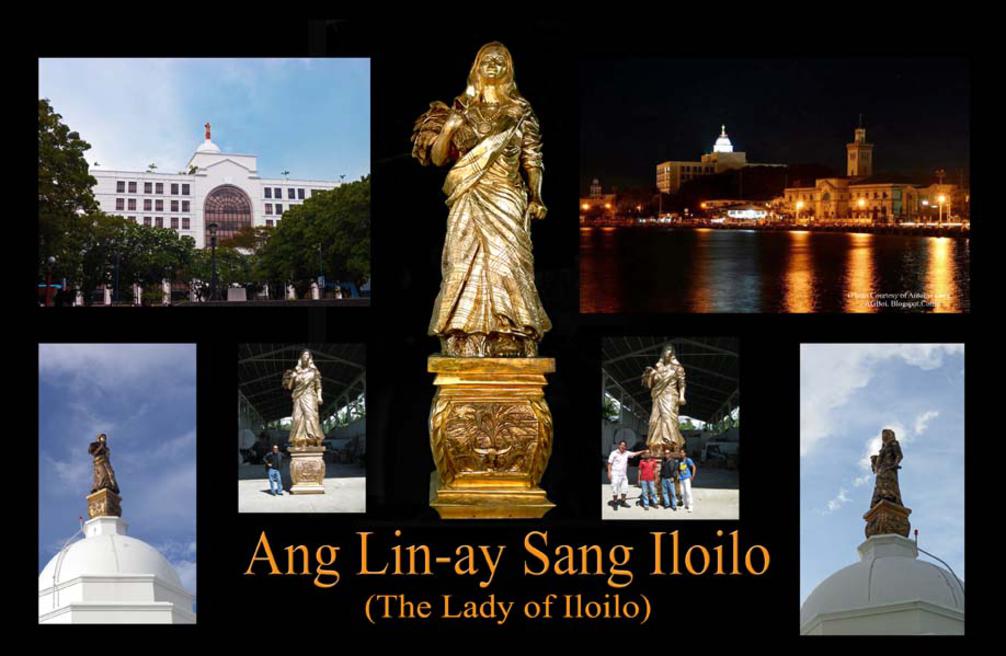ed defensor
My World of Art
multi-media visual artist of Iloilo City,
Philippines
 | ||||||
Ang Lin-ay Sang Iloilo
 | ||||||
The Lin-ay Sang Iloilo (The Lady of Iloilo) is an 18-foot bronze statue, weighing 1.7 tons, which presently stands atop the dome of the new Iloilo City Hall at Plaza Libertad, Iloilo City. It was commissioned by the Honorable Mayor of Iloilo City, Jed Patrick Mabilog, in 2011, after a visit to Washington D.C. where he was able to gaze in admiration at the Lady of Freedom, the bronze statue atop the Washington Capitol, one of the iconic statues symbolizing the United States of America. Thus when the Honorable Mayor returned to his city he outright thought of creating as well an icon for the City of Iloilo which was to stand on top of the dome of the new City Hall being constructed at the time. Although the statue was meant to be an icon for Iloilo City, after its completion the whole countenance of the statue symbolized not only the City of Iloilo but also the Province as well. The statue was funded by an extraordinary Ilongga philanthropist who wished to remain anonymous .
After a study was made which was later approved by the Mayor with minor revisions work on the statue commenced in March 2011. The site of the workshop was the Herbich International Art and Manufacturing Corporation at Cotcot 617 Liloan, 6002, Cebu, an art foundry company owned by a German national, Karl Herbich, and his Filipina wife Helen. It was managed by their Filipino-American son, Franz Herbich. The making of the statue had to be done in Cebu since there was no foundry company that is to be found in the city of Iloilo which was capable of making a bronze statue that big. By a coincidence of good fate I met Franz Herbich in the Visayas Biennale in Cebu City in 2010 when I was given the Garbo Sa Bisaya award. I had no inkling whatsoever that I would have a need for him and his foundry company in the following year.
In March I brought to Cebu my working crew, consisting of two major sculptors, Joe Amora and Harry Mark Gonzales, and a utility man, Juan. We were reinforced at the foundry company by the company’s major sculptor named Mat, and of course behind us were the entire working force of the foundry.
Soon after arrival in Liloan we commenced work on the model which was made of styrofor which would be covered with plaster for the refinement of the details. With just brief intervals for rest and recreation we finished the model in April 2010. It was then cut into several parts in preparation for the making of its mold and its eventual casting into bronze. It was then that we had quite a long rest since the matter of making the mold and the casting into bronze were no longer our responsibility.
The whole statue, all eighteen feet of it, was finally finished on July 1 2011. After it was inspected and scrutinized by my team together with two engineers of FF Cruz & Co., the company that was building the new City Hall, the Lin-ay was loaded by Karl and Franz in their six-wheeler truck and transported to Iloilo on July 7 2011 via a Trans-Asia passenger and cargo ship. Since the new Iloilo City Hall was not yet finished at the time, the Lin-ay was meanwhile kept in the stockyard of the City Engineer’s Office at Molo, Iloilo City and it stayed there until it was ready to be installed on July 20 2011.
The installation of the Lin-ay was rather problematic at the time since the crane of FF Cruz and Co. which could reach the dome of the new City Hall was no longer at the site. And so the engineers had to devise an ingenious way of bringing up the Lin-ay from the topmost floor of the City Hall to its ready made base on top of the dome. It was a combination of an improvised sled, pulleys, and brute strength which finally delivered the Lin-ay to its final resting perch. It practically took the whole afternoon for this event to unfold, an event that was full of drama, fear, anxiety, tribulation and finally ecstasy. It was one of the scariest moments of my life but all that was compensated for when I heard the applause of the working men and the engineers when they finally fixed the Lin-ay on her perch on top of the dome.
The Lin-ay was unveiled on August 25 2011 on the occasion of the celebration of the Charter Day of Iloilo City. In attendance were the Honorable Mayor himself, Jed Patrick Mabilog, the Congressman of the Lone District of Iloilo City, Jerry Trenas, Vice-Mayor Joe Espinosa III, majority of the Councillors of the City, Franz and Yasi Herbich, and several other invited guests.
So what does the Lin-ay actually symbolize? To explain this let me just quote from my short speech during the unveiling:
“When the good mayor, Honorable Jed Patrick E. Mabilog told me that he wanted a symbol of Iloilo on the dome of the New City Hall, the very first thing that came to my mind was that “I had dreamed of this before.”
Yes, as early as 15 years ago I already dreamed of a commission that would enable me to mold the symbol of Iloilo in brass or in bronze – the image was already clear and complete in my mind.
I dreamed of it in the same scale as it is today, but on the ground. Never did I imagine that it would be standing on the top of a dome and make history as the first of its kind in the whole Philippines.
What you see is the graceful figure of a beautiful peasant lady standing valiantly and proudly on a harvested field of rice.
I envisioned a symbol associated with our rice industry because to my mind Iloilo could not be represented otherwise since we have always been known as the rice granary of the whole Visayas, and several times in our history, of the whole country.
And to me, since our great city is the making of our great province, Iloilo therefore is both city and province. Thus, a symbol for one may as well be a symbol for the other.
What you see is a Lin-ay wearing the traditional bandana usually worn by farm ladies to protect them from the heat of the sun. On her neck she wears an ethnic necklace, symbolic of her ancestry, as she comes from a rich mythic past, from the Maragtas, the “Barter of Panay,” and the long line of heroic datus that peopled the island of Panay.
Her right arm cradles a bunch of harvested rice, symbolic of our prosperity. Her left hand holds another symbol of prosperity, the scythe or “garab” which has long been the traditional harvesting tool in the region. I remember when I was a child in the farms of Mina, Iloilo, whenever I saw a “garab,” I knew right away it is “good times” for it is harvest time.
She wears an embroidered blouse, symbolic of one of the popular traditional arts of the city and province. On top of it is a “sablay” of a “hablon,” the textile which contributed to Iloilo’s becoming the second city of the Philippines, next to Manila, at the onset of the 19th century.
The whole figure of the Lin-ay is highlighted by the “patadyong,” our native hand-woven wrap-around skirt, for which no other province is better known than Iloilo. As a bonafide historian I dare say that Iloilo has the best patadyong in the whole country.
The Lin-ay is standing on a pedestal with four sides carved with major assets of Iloilo – front shows rice-farming industry, at right is sugarcane, left is fishing industry and back depicts education since Iloilo is considered as the educational center of the Visayas and Mindanao.
Thus, I have outlined the meaning, symbolism and history of the “Lin-ay Sang Iloilo.”
I would like to thank the good mayor for his vision, love and passion for Ilonggo culture and art, for conceiving this project and making history for the city.
Consequently, I would like to thank our donor, a beautiful person who truly loves Iloilo, a philanthropist in the true sense of the word, who gives without any strings attached, who has no political ambition whatsoever, and most importantly, who does not want to be mayor and who wants to remain anonymous, unknown even to the beneficiaries of this project.
I would also like to thank the valiant workers and carpenters of the City Hall building for braving all odds, dangers and threat to life in bringing the Lin-ay up to her pedestal to stand there forever as the symbol of the greatness and pride of Iloilo. Their applause after the Lin-ay was perched will forever be embedded in my heart and memory.“
Gallery 1: The Lin-ay Story




